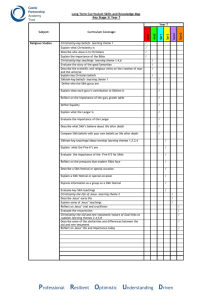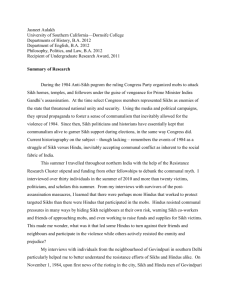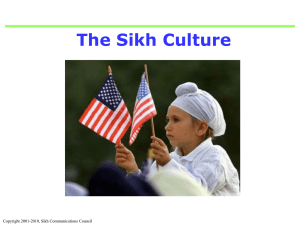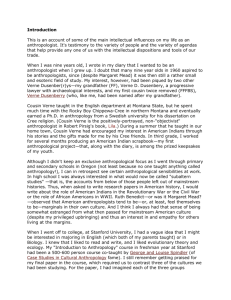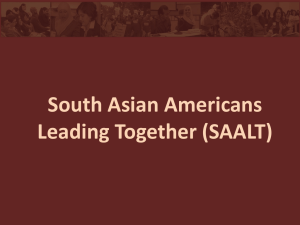South Asian Canadians
advertisement
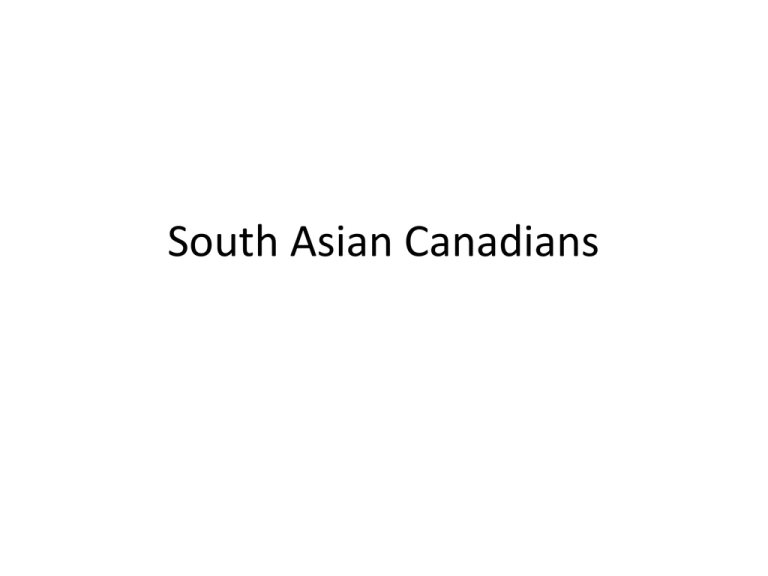
South Asian Canadians • The number of people in Canada of South Asian origin, as defined by Statistics Canada, is growing considerably faster than the overall population. • Between 1996 and 2001, for example, the number of people who reported a South Asian origin rose by 33%, while the overall population grew by only 4% Mostly 1 generation • A substantial majority of the population with South Asian origins living in Canada was born outside the country. • In 2001, 68% of Canadians who reported a South Asian origin were born outside of Canada, compared to 18% of the overall population. • The large majority of the Canadian population of South Asian origin is concentrated in Ontario and British Columbia. • In 2001, Ontario was home to 62% of all Canadians of South Asian origin, while another 22% lived in British Columbia. • Canadians of South Asian origin are somewhat more likely than the overall population to be children or young adults, while they are less likely to be seniors or approaching retirement age. • In contrast to the overall population, men make up a slight majority of Canadians of South Asian origin. • In 2001, 50.6% of people of South Asian origin were male, compared with 49.1% of all Canadians. • Max Weber's `The Religion of India' and places it in the wider context of his work. It tries to show in detail how Weber's study of India formed part of the comparative analysis of world civilizations which was the natural result of his interest in the causal antecedents of the rise of industrial capitalism in the West Weber’s thesis • The Indian social system was influenced by the concept of caste (varna).[2] It directly linked religious belief and the segregation of society into status groups. Weber goes on to describe the caste system: • (the Brahmins - priests, • the Kshatriyas - warriors, • the Vaisyas - merchants, • the Sudras - laborers • and the untouchables). • Weber pays special attention to Brahmins and considers why they occupied the highest place in Indian society for many centuries. • With regard to the concept of dharma, he concludes that the Indian ethical pluralism is very different both from the universal ethic of Confucianism and Christianity. Hinduism and Buddhism • He notes that the caste system prevented the development of urban status groups • Secular ethic and impact of Hindu beliefs on economy • Weber discussed what influence Hinduism and Buddhism had on the mundane activities, and how they impacted the economy Other wordly Mysticism • . He noted the idea of unchanging world order consisting of the eternal cycles of rebirth, and the deprecation of mundane world.[4] • By the traditionalism of the caste system supported by the religion, the economic development is slowed as, - according to Weber the "spirit" of the caste system worked against the development of capitalism.[5] Sikhism A progressive religion well ahead of its time when it was founded over 500 years ago. Sikhs make up 1.8% of India’s pop. Sikhs worldwide =-25 million. Charismatic leader-Guru Nanak • He had a revelation of those who step forward as disciples, or Sikh’s which literally means “learners” • In 1499, found he had a mission to awaken people to the presence of God. • He sought to teach contemporary society about socially responsible living. • The Sikh religion today has a following of over 20 million people worldwide and is ranked as the worlds 5th largest religion. • Sikhism is a monotheistic religion that originated in the 15th century in the Punjab region… Sikhs in Canada • In 1897, Queen’s Jubilee celebration a Sikh regiment in parade. • By 1908, 5000 had come to Vancouver. • A Kalsa Diwan Society then opened in West Vancouver • After that, BC gov’t enacted legislation that virtually eliminated entrance . • Legislation-denied right to vote • Immigrant must have a high amount of money to visit Canada. • South Asian were described as “yellow peril” “brown invasion” Komagata Maru • A steamship owned by a wealthy Punjabi businessman, Gurdit Singh. • The ship carried 376 immigrants from India, 351 were Sikh. • The ship was denied landing rights and forced to return to Calcutta. • The Sikh immigration to Canada was almost nothing after this and many in Canada already went to the US or back to India. • Little immigration prior WW2. • However, some increase as a result of the 1952 Immigration Act that allowed quotas. Point System • Change immigration laws in 1967. • Eliminated discrimination based upon race, religion and country of origin. • Half of immigration of from India were Punjabi Sikh who could enter with “semiskilled occupations, 1970s • Some anti-Asian and south Asian prejudice event particularly during economic downturns • Multiculturalism first announced in 1971, helped to change attitudes. • 1984 a watershed, problems in India… • Many young men came to Canada • Canadian Sikh then became concern for building up the economic, social and political base of the community. • In the last decades of the twentieth century, the Sikh population grew by 89%. Rituals • Personal piety and devotion important • The devout begin their day by “meditating on the devine name” • Recite five liturgical prayers including the “japji of Guru Nanak. • Sikh can recite prayer from memory-morning and evening observances. Social Change • For first generation Sikh, rituals are without question • They worry however, that 2nd and 3rd generation are becoming “theologically illiterate” (Scott, 326) • Visits to gurdwaras, however, help young Sikh’s remain in touch. Identity • An ethno religious group • A religious identity and a national identity • Sikhs tend to see themselves as Punjabi Sikh Canadians. • Although Sikhs come from outside India such as East Africa, South Africa and the UK. • Gurdwaras serve as a bulwak against assimilative pressures.
